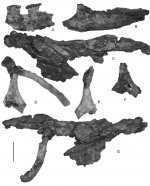Fred Ruhe
Well-known member

Amanda Cordes-Person, Carolina Acosta Hospitaleche, Judd Case, James Martin, 2019
An enigmatic bird from the lower Maastrichtian of Vega Island, Antarctica
Cretaceous Research, in press
doi: https://doi.org/10.1016/j.cretres.2019.104314
https://www.sciencedirect.com/science/article/pii/S0195667118304944
Abstract: https://www.sciencedirect.com/science/article/pii/S0195667118304944?via=ihub
We describe a partial skeleton from the lowest Maastrichtian levels of the Snow Hill Island Formation (Vega Island, West Antarctica). Because of the anatomical differences with the Antarctic Vegavis iaai and Polarornis gregorii, this fossil is recognized here as a new genus and species. The results of our phylogenetic analysis suggest that A. capelambensis would be placed inside the Ornithuromorpha, and probably nested within the Ornithurae. This provisional assignment could only be confirmed through the finding of most complete and better preserved specimens. Antarcticavis capelambensis is the geologically oldest bird described from Antarctica.
Enjoy,
Fred
An enigmatic bird from the lower Maastrichtian of Vega Island, Antarctica
Cretaceous Research, in press
doi: https://doi.org/10.1016/j.cretres.2019.104314
https://www.sciencedirect.com/science/article/pii/S0195667118304944
Abstract: https://www.sciencedirect.com/science/article/pii/S0195667118304944?via=ihub
We describe a partial skeleton from the lowest Maastrichtian levels of the Snow Hill Island Formation (Vega Island, West Antarctica). Because of the anatomical differences with the Antarctic Vegavis iaai and Polarornis gregorii, this fossil is recognized here as a new genus and species. The results of our phylogenetic analysis suggest that A. capelambensis would be placed inside the Ornithuromorpha, and probably nested within the Ornithurae. This provisional assignment could only be confirmed through the finding of most complete and better preserved specimens. Antarcticavis capelambensis is the geologically oldest bird described from Antarctica.
Enjoy,
Fred
Last edited:




